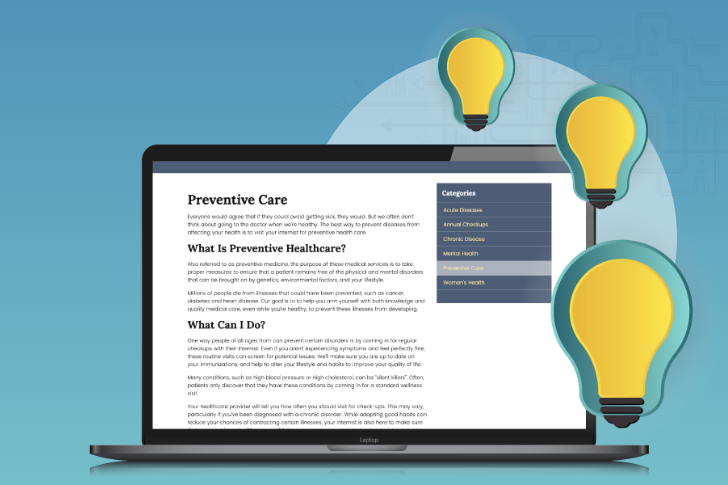Medical practice websites can fulfill a lot of different functions. They can provide a way for patients to schedule their own appointments. They can provide information resources for patients and a marketplace for selling and purchasing medical equipment and supplies. They can provide a forum for doctors to present their views and share their expertise.
The way you build your website should be based on your goals and needs. Here we will present examples of professional website style options built for various purposes and serving different needs.
We will delve into custom medical website design with examples of best-in-class healthcare websites. We’ll show you which features work best to highlight your services. And we’ll explore what goes into websites that outperform the competition.
Hospital/ Medical Center Websites
Hospital/medical center websites focus on a single hospital, medical center or healthcare system, providing detailed information about services, healthcare providers, hours of operation and locations.
Visitors to these sites get an overview of the practice and may search for providers specializing in their healthcare needs. Viewers may also get an opportunity to submit questions and read reviews written by patients.
Medical Marketplace
In addition to information about the practice’s services and medical providers, these sites may include reviews of medical providers, testimonials from patients, and online appointment booking.
Medical Practitioner Websites
Individual medical practitioners can create websites that market their services by displaying their knowledge and expertise through blogs, testimonials, and text, accompanied by photos and graphics, offering details about treatment options.
Telemedicine Platforms
These days, office visits and consultations often can be accomplished online via telemedicine platforms. This increasingly popular way of providing medical services without requiring in-person meetings offers convenience for patients, medical providers and office staff.
Which website design works best?
To find the right type of website for your practice, consider your goals.
Do you want to provide medical information and resources for patients with particular medical needs? Do you want to sell medical supplies through an e-store online? Do you want to give patients the option of booking their appointments online, without having to call your office?
With your priorities in mind, consider your technical options. For example, if you want to include an e-store to sell supplies, your design might be an e-commerce platform that also includes medical information. E-commerce sites perform better with multiple photos and videos. And easy navigation to the marketplace on your website is also essential to its success.
If online booking is a priority, choose a website that emphasizes your doctors’ credentials and experience.
Include The Essentials To Build a Solid Foundation
Build a strong foundation for your website and add to it, based on how and why you want to connect to your web visitors.
Medical Catalogs and Portal
Basic and clean, these websites don’t require a complex design. There should be multiple search bars with at least one on each page so visitors can easily navigate to the information they seek.
Hospital/ Medical Center Websites
These websites can provide a welcoming introduction to new patients through a simple yet effective approach.
For example, the site’s homepage could feature a looping video that provides a basic overview of the facility and its services.
Another way to introduce new patients to your practice would be to include photos of doctors and other medical providers against a backdrop of the interior of your offices.
A navigation bar should be placed on each page so searches are easy for patients to conduct. And patients should be able to use the header at any time to access information including phone number and address, social media accounts and insurance information.
The site should also strive to establish credibility and confidence in your practice through highlighting accomplishments and through patient reviews and testimonials.
Medical Marketplace
These websites are intended to connect patients with specific medical providers. This could mean narrowing down patient options regarding specific locations, credentials, insurance accepted and other variables.
Including an advanced search engine can make this process easier for the web visitor.
To help visitors consider options, the site should include ratings and reviews, and profiles of service providers that include extensive information about education, experience, and certifications.
Every page on the site should include a Call To Action button or link where visitors can make an appointment, reach out via email or phone or get additional information.
Medical Practitioner Websites
These websites focus on the practitioners’ professional goals and on details about the practice. They serve as the professional equivalent of a personal website. The objective of these sites is to gain patients’ trust and establish credibility.
To do that, the site should include photos of the doctor or doctors. Another way to build a strong reputation is to post blogs about medical topics of interest to your patients and potential patients.
These sites can also include the option of signing up for a newsletter subscription, links to relevant articles and news, and Call To Action (CTA) buttons.
Online Doctor Consultation Platforms
If you want to make online consultations part of your website experience, straightforward, easy-to-navigate pages are a key feature that should be included.
You can start with a brief video on the home page or a search engine that directs patients based on their symptoms, medical issue, insurance carrier or type of specialist sought.
Because patients seeking consultations may be any age or in any physical condition, it is important to make the site as easy to use and travel through as possible. Readily available navigation tools and CTA buttons should be on every page.
10 Best Medical Clinic Website Designs
Topnotch medical practice websites often include: mobile-friendly features so the site can be viewed and function well on any device, fast load times, internal search options, patient portals, messaging capabilities, online appointment booking and prescription renewals, photos, and informational videos.
In this section, we will discuss examples of the 10 best medical website designs for healthcare providers, pointing out their strengths and areas for potential improvement.
Rest Assured- Best Website Accessibility
The Rest Assured medical website design is available to all users and was designed and developed to meet the WCAG 2.0 AA level of accessibility compliance, a wise option for companies in any industry.
This website was created with accessible design features in mind, such as big, high-contrast fonts and simple keyboard navigation. In addition, mobile readers and other text-to-speech tools use alt text on all pictures on the Rest Assured site to correctly read and understand material for visually impaired individuals.
IU Health- Best Website Search
Indiana University Health does an excellent job of offering a powerful keyword search option to its patients. Medical services, news and events, providers, and locations may all be blocked from on-site searches. In the site’s left margin, visitors may see a list of recent searches, which helps them keep track of their search history. In addition, distinct search capabilities for Providers, Medical Services, and Locations are in the header menu.
Mercy Health- Best Website Imagery
Mercy Health’s website design uses dynamic graphics and color. The consistent use of rich, vivid imagery across the site, from the carousel beneath the banner to various photos throughout the site, generates a sense of enthusiasm and optimism. Although the use of a rich, vibrant green hue for the search box was an excellent option for promoting a sense of health and well-being, the typography within the box needs more contrast to improve readability.
Centura Health- Best Clean Design
The Centura Health healthcare website design has a clear, basic information architecture. There are just five major links and two subsidiary icons in the navigation menu. In the top navigation bar of some healthcare sites, more than 20 things are fighting for attention. It is better to keep it simple and uncluttered, as Centura Health has done.
The usability of Centura Health’s medical web design is considerably enhanced by its use of basic, straightforward navigation and prominent display of a search box in the middle of the main page. The site also adheres to accessible design best practices by employing big, high-contrast fonts that are easier to read for internet patients with vision impairments.
Regional One Health- Best Engaging Video Web Design
Visitors to this website encounter an engaging video that tells a story, features providers in action and shows scenes from inside and outside the facility. The dramatic footage captivates the viewer and supports the belief that Regional One Health has the healthcare solutions they seek.
Arkansas Surgical Hospital- Best Patient Reviews and Testimonials Web Design
Potential patients rely on previous patients’ evaluations when making their decisions about where to seek healthcare. The Arkansas Surgical Hospital uses a carousel to show patient testimonials to great effect, giving viewers confidence in the medical providers at this facility.
Rush Medical- Best Engaging Content
Rush University Medical Center’s website uses well-written articles to engage visitors. The easy-to-navigate website includes news about the medical center, health issues, available seminars and a selection of highlights from social media posts.
Mayo Clinic- Best Medical Info Delivery
This website, promoting what has long been regarded as one of the best medical facilities in the country, features information arranged and delivered in effective and efficient ways. There is a comprehensive overview of diseases and conditions. The site also features a search engine that allows patients to look up conditions alphabetically or through a symptom checker.
Cleveland Clinic- Best Mobile-Friendly Design
The Cleveland Clinic’s website features a mobile-friendly design that also works well on a desktop computer. Content is categorized and arranged for both doctors and patients, making it easier for site users to zero in on the information they want. The site also features a health library complete with videos, articles and health resources.
Infinite Medical Express- Best Minimalist Design
Infinite Medical Express is a simple website with a lot of useful information, including healthy tips available via a link on the home page.. Visitors to the site may easily access the patient portal to schedule appointments and make online payments.
Wrapping Up
At Officite, we have the experience and the expertise to let your website reach its full potential. We’ve designed and developed high-performing websites for hospitals and medical health organizations for years. Visit us at www.officite.com to learn more.



